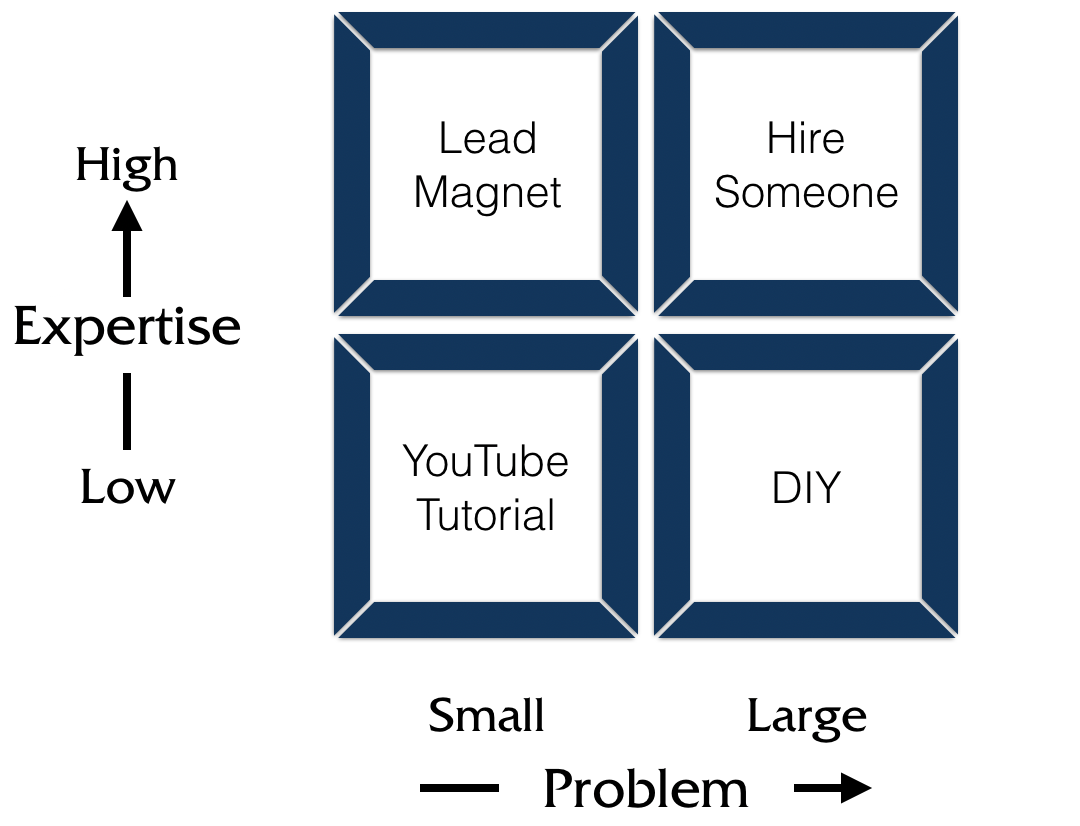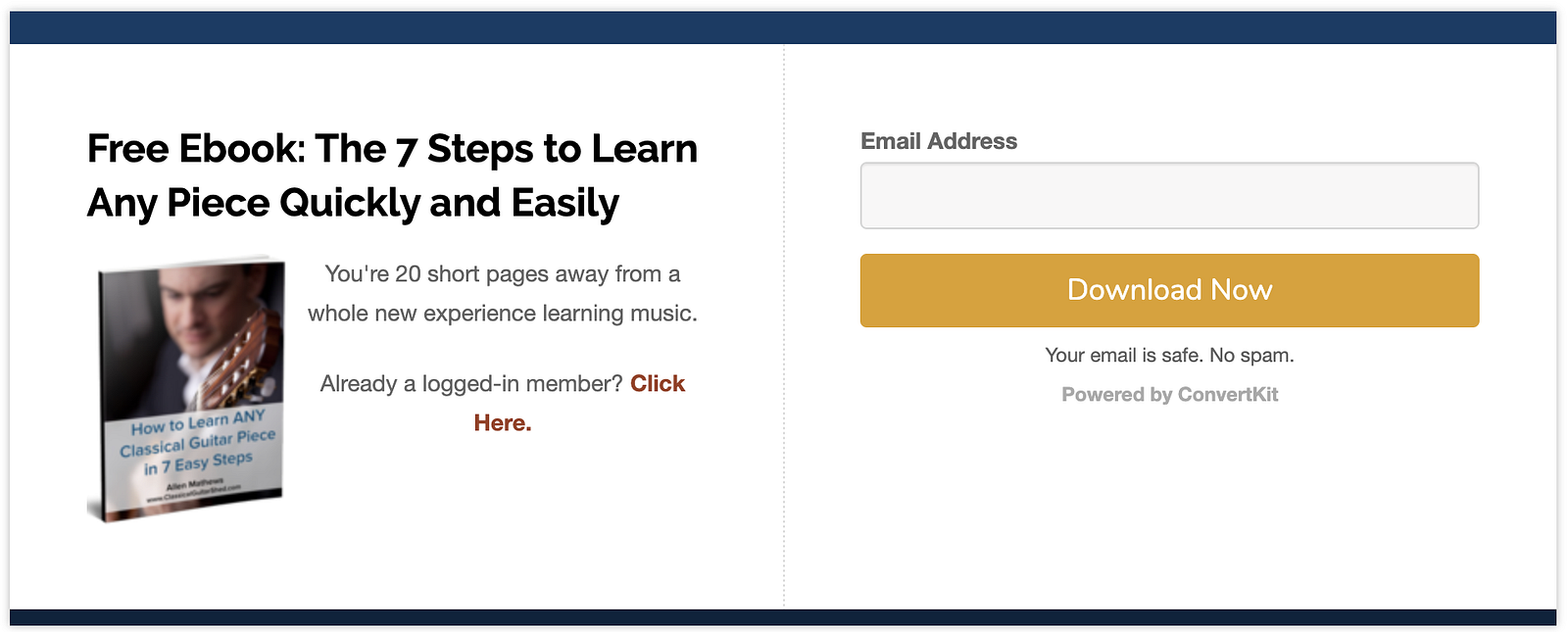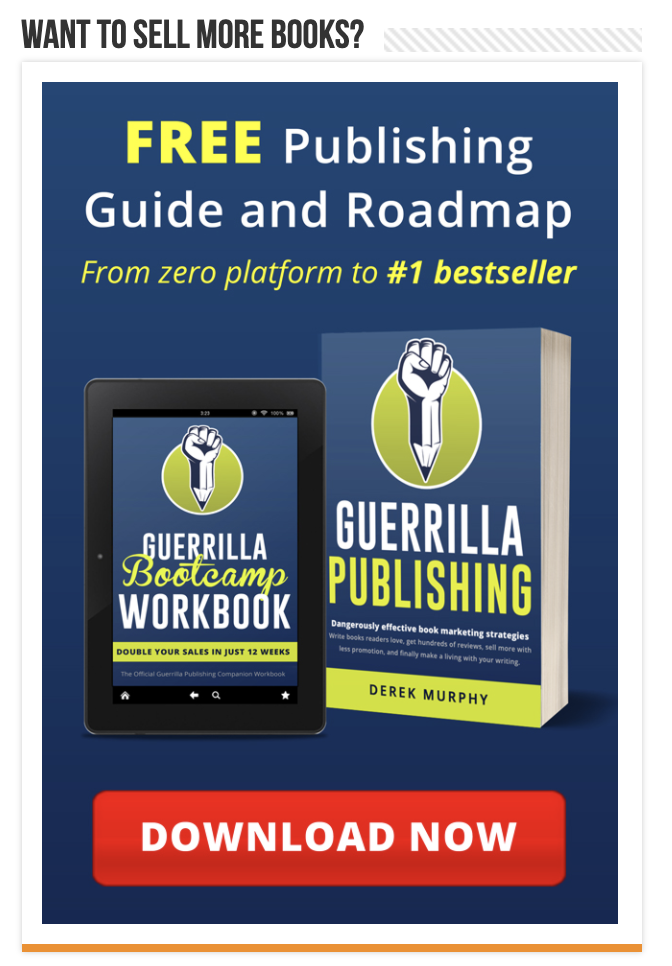A Lead Magnet is a short, digestible, nicely designed example of your work.
The right kind of Lead Magnet will build you an email list of potential customers who all face the same problem. If you design your Lead Magnet to solve a small problem well, you can:
- demonstrate your expertise,
- qualify your leads, and
- build trust with people to whom you can sell in the future.
“Build an audience, and sell them what they want.”— Derek Halpern
The smallest solvable problem makes the best Lead Magnet.
In the Internet age, nobody faces the problem of ‘not enough information’ anymore. All of the world’s information is available to anyone with an Internet connection.
There is a different problem that we all share. ‘How do I find the specific information I need to solve this problem right now?’ Answer this question well to find opportunity.
If you regurgitate everything you know about a topic, you will overwhelm someone looking for a simple solution.
Offer only the amount of information that someone needs to fix a small problem. Then, when it comes time to fix a bigger problem, they will come to you first.
Lead Magnets let people try you before they buy you.
A Lead Magnet is like a free sample at the grocery store. As you walk through the aisle shopping for things to eat, someone asks if you’d like to try some guacamole.
They don’t ask you to invest in their avocado farm. They give you a small, non-threatening sample first. And if you like it, you can become a customer.
This may not solve your bigger problem of being hungry, but it does solve a smaller problem, of finding something tasty to eat.
In 2007, an MIT study found that people think a zero dollar price adds to the benefits of a product. The “last benefit difference” is psychologically different for zero dollars.
It turns out, people assume that putting in the effort to make something for free means it must be good. At the very least, it should be good enough to justify the time taken to consume it.
Nobody puts rotten avocados into their free sample guacamole. People have learned that a Lead Magnet is created to be the best example of your work.
A Progression Of Solutions
Small problems are easier to solve than difficult problems. But how do you find someone who can solve a big, complicated problem for you?
You test them with a small problem, that’s how.
Before you go into surgery, it’s good to see how your doctor puts on a bandaid. If your doctor doesn’t know how to bandage a minor wound, would you really trust them with fixing a major wound?
You can test your doctor’s bedside manner in a verbal consultation. You will see firsthand her ability to answer your questions and listen to your concerns. That is more important to your selection process than knowing how well they perform in the operating room.
The same goes for you and what you sell. People will decide to invest in your bigger solutions based on how well you solve a small problem for them.
Help your future customers get to know you by solving a small, specific problem. This will increase their trust and their likelihood to buy from you.

Lead Magnet Case Study — Classical Guitar Shed
Allen Mathews is a classical guitar teacher. He knows his customer avatar really well — they are generally men over 50, and they played a lot of guitar when they were younger. When they try picking up their guitar again, they find they need some help with the basics, so they turn to Google.
They search for things like:
After providing a long, in-depth tutorial, earning the trust of his reader, Allen offers a Lead Magnet:

For guitarists who are learning new songs, this is exactly the kind of problem they want to solve. If they don’t subscribe, Allen nudges them with a pop-up, and a second lead magnet:

These Lead Magnets have built Allen an email list of guitarists, and he sells his membership program to this audience. He doesn’t sell to strangers at the train station, or to randos on Twitter. He builds an audience, and sells them what they want.
Lead Magnet Case Study — Derek Murphy
Derek Murphy designs book covers. His Customer Avatar is clearly defined: an author who has written a book, and they need a cover designed.
Derek knows his audience very well, because he is an author himself. He’s been through traditional and self publishing, so he can talk to his audience knowledgeably about the different options.
When you get to Derek’s website, you see this in the sidebar:

This Lead Magnet builds Derek a list of authors who want to self-publish their own book. He is generous with his expertise, which builds trust with his audience. He even created a free 3d book cover tool so anyone can quickly make a good-looking image for their website.
When an author on Derek’s list needs to get their book cover designed — or has a friend asking for a recommendation — Derek is the designer they use.

Search For Answers, Find a Lead Magnet
I’m sure this has happened to you. Once upon a time, you faced a problem. It was a minor inconvenience. You didn’t want to pay somebody to fix it, but you were willing to do a little bit of research to figure out how to fix it yourself.
After going to Google for a few answers, you discovered that this problem is actually much more complicated than you thought.
This might be a big project, so you settled in for a few minutes of research.
You have plenty of information; each of the dozen browser tabs you opened is full of material. Some are detailed tutorials, with lots of ads crowding out the information. Some are simple pages, with a promise and a form, asking for your email address.
You watch a YouTube tutorial, or click an ad for a free course. You have probably subscribed to some email lists to get the solutions you want.
Maybe this solves your problem completely, but it might also reveal how much more work there is to be done.
The larger your problem gets, the more time you are required to invest in it. This makes it more likely you will change that investment from time to money.
You can often solve a small problem with a little bit of research. But a big problem takes some investment. Justify the investment for people by solving a small problem for free.
Subscribing to these lists engages you with experts who can solve your bigger problems in the future. If the problem ends up being bigger than you thought, the expert who sent you the Lead Magnet is at the top of your list when you need to hire someone.
How To Design Your Lead Magnet
- Select a small problem your customers typically face. Listen to what they say in forums and conversations. Pay attention to the language they use to talk about their problem.
- Solve this problem for free. This may be in the form of a PDF, a short video, or an email series. Make it as short as you can.
- Create a subscription gateway. Set up a simple landing page that describes the benefits and outcomes of your solution. Install a form that requires their email address before they can access the Lead Magnet.
- Offer the link in communities where your customers congregate. The forums and Facebook groups are the ponds, and your Lead Magnet is the bait.
Upsell From Your Lead Magnet
Attention is a valuable resource. Don’t waste it.
If you have someone’s attention online, that means that they have:
- Found you online
- Consumed some of your content
- Decided your Lead Magnet was valuable
- Gave you their email address to access it
- Read through your Lead Magnet until the end
This person is what we call a ‘qualified lead.’
They have qualified themselves because they:
- Face the problems your customers face
- Shown themselves willing to provide you with their contact information
- Are more likely than the general populace to buy from you
They have gone 3 steps forward in the 4-Step Marketing Cycle — they Know you, they Like you, and they Trust you.
At the end of every Lead Magnet, ask people to Buy from you.
The call-to-action can be simple: book a call, or look at my rates, or buy this small product. But if you don’t end every Lead Magnet with a CTA you are literally leaving money on the table.
Lead magnet design checklist
- Your lead magnet addresses a problem your customer avatar faces
- The title is clear and descriptive (and maybe a little clickbait-y)
- The medium is quickly digestible (a 5-page report is better than a 7-hour video series)
- Delivery of the lead magnet is automated through your email service provider
- A professional graphic designer was involved in the production (or was asked for their opinion about the lead magnet design)
- The lead magnet ends with a call-to-action to move to the next stage of your sales funnel
A Lead Magnet is a risk-free method to try one of your solutions. If you solve a small problem well enough, your customer will hire you to solve bigger problems.
When people facing a big problem have searched for a small solution, they should find you. This will put you on the short list of people they are willing to pay to fix the larger problem. Through your Lead Magnet, you have already become their teacher and advisor.
Try This Lead Magnet Template

I’ve produced hundreds of Lead Magnets over the past decade, for myself and for clients.
Using what I’ve learned, I’ve created a simple Google Doc template. This expedites the production of a Lead Magnet that converts.
You can get this template for free by subscribing to my newsletter here -> https://stellarplatforms.com/template/lead-magnet





![Educate yourself before AI educates you [Now Enrolling – AI-Powered Professionals]](https://caelanhuntress.com/wp-content/uploads/2025/04/educate-yourself-featured-500x383.png)
Leave A Comment